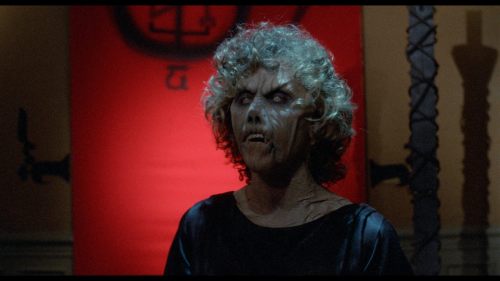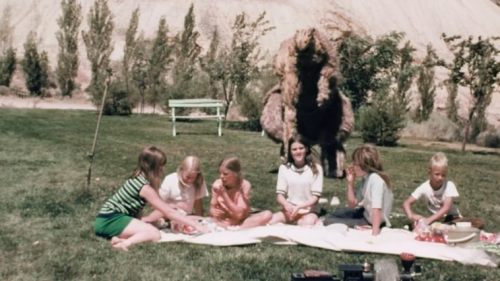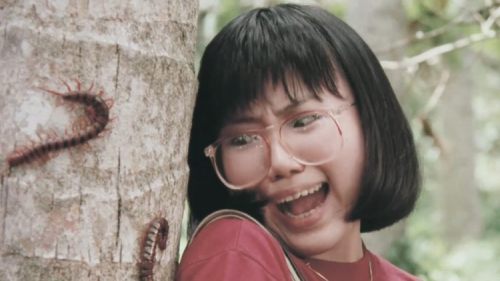Everybody’s Into Weirdness: FRIGHT NIGHT (1985)
The Alamo Drafthouse is a brand built on weird. Beyond being situated in a town that has long aspired to remain eccentric in the face of all normality, it’s easy to forget that the original Alamo started as something of a private screening club, running prints of the odd and obscure into all hours of the night*. Though the company has obviously grown into an internationally recognized chain of first run movie palaces, the Drafthouse Ritz in Austin, Texas remains committed to showcasing genre repertory programming, namely via its Terror Tuesday and Weird Wednesday showcases. This column is a concentrated effort to keep that spirit of strangeness alive, as programmers Joe A. Ziemba and Laird Jimenez (often pulling from the extensive AGFA archives) are truly doing Satan’s bidding by bringing ATX weekly doses of delightful trash art.
The thirteenth entry into this disreputable canon is the vampire teen sex horror staple, Fright Night…
Year: 1985
Trailers: An American Werewolf in London; The Howling
(This week, we return to Terror Tuesday in order to celebrate Fright Night’s 30th birthday via this rare, immaculately presented 35mm screening…)
Updating Rear Window has been a time-honored tradition since Alfred Hitchcock’s masterwork first blew doors off of theaters in August of ‘54. The best practitioners of this brash borrowing took the formula – man witnesses a neighbor’s murder and, after his protests fall on deaf ears, embarks upon his own quest for justice – and apply it to whatever personal story they’re telling. Brian De Palma was (obviously) the king, as Sisters (1973) and Body Double (1984) acted as updates while simultaneously staying in dialogue with other recognizable staples of Hitch’s filmography. Christopher Reeve starred in the TV remake of the classic in ‘98, following his tragic horseback riding accident that left him a quadriplegic. DJ Caruso subbed in Shia LaBeouf for Jimmy Stewart in the underrated ‘07 teen thriller, Disturbia. Like the rest of his very best work, Hitch had crafted a perfect pop hook that was easy to swipe – skeletal storytelling framework for other filmmakers to build around.
Thankfully, one of the artists who took a crack at modernizing the blueprint was Tom Holland, a writer/director who was already well versed in Hitchcock, having penned Richard Franklin’s stellar ‘82 sequel to Psycho. Holland is one of eighties horror’s less talked about geniuses. His scripts for The Beast Within and Class of 1984 are lurid pieces of provocative trash art, providing the backbone for Philippe Mora and Richard L. Lester’s legit cult classics. However, Holland’s debut feature, Fright Night, remains not only his defining work (yes, even better than Child’s Play), but also one of the best horror films of any decade. Amalgamating Last American Virgin-style teen lust, thumping drum machines (provided by Terminator maestro Brad Fiedel) and an all-timer villain in Chris Sarandon’s vamp bachelor, Jerry Dandridge, Holland crafted a new classic that may be reminiscent of Hitchcock’s masterwork, but is still very much doing its own thing. Borrowing does not necessarily mean stealing, because in this case Holland is giving back even more than he appropriated.
The central conceit of Fright Night is simple: Charley (William Ragsdale), a horny teenage kid living with his single mother (Dorothy Fielding), suspects that his dashing new neighbor (Sarandon) may be a vampire. His evidence? For starters, he saw Jerry and his live-in handyman (Jonathan Stark, playing Igor like a sinister Bret Easton Ellis smarm-ball), carrying an ornate coffin into the basement. Then there were the beautiful women being dropped off at Jerry’s place that ended up as murder victims on the news; their bodies mutilated and decapitated. But the real clincher is the fact that Charley saw Jerry’s fangs through the window, just as he was about to dine down on his latest buxom dinner. Of course no one will hear his hysterical cries– not even his cute, neglected girlfriend, Amy (Married With Children’s Amanda Bearse), or super weirdo best friend, “Evil” Ed (Stephen Geoffreys). He’s a regular LB Jeffries, without the professional resume to try and back up his dubious claims.
Fright Night exists in a persistent state of sexual interruption. A miasma of hunger hangs thick over every frame, beginning with Amy kicking Charley off of her; afraid to take the big leap into the sack despite the fact they’ve been going together for a year. Once Amy changes her mind, Charley’s got the binoculars out, spying on his new neighbor’s shady dealings across the street. Like any sane person, Amy bolts when she realizes she’s being overlooked for a new fascination, and Charley can’t help but be aroused by the constant nudity that seems to be occurring through the blinds of Dandridge’s overly baroque suburban estate (seriously – the interior design of this otherwise ordinary home must’ve been sketched by an 18th Century Priest). Holland keeps this carnal tension coiled for the majority of his movie’s running time, as we’re waiting for the sex to explode along with vampiric violence. The writer/director understands the innate lustfulness contained within the monster, and uses it as a symbol for how American teenagers are constantly in sexual limbo, always looking for the next chance to lose their V-Card.
It helps that the object of everybody’s attraction in Fright Night is Jerry Dandridge, a legend even in the pantheon of great horror villains. Sarandon is as suave as Ragsdale is tweedy and awkward, oozing a Miami Vice lothario charisma that is never less than completely intoxicating. This is the stuff movie stars are made of, as Sarandon’s magnetic gaze pierces through the screen via chestnut eyes. Jerry glides in and out of scenes, as if floating on pure effervescent sex, but also proves to be lethal without warning. Most impressive is that Sarandon makes Jerry feel so of his time (decked out in turtlenecks and pull over sweaters) while also carrying an eternal menace that projects eons of experience. This is the fantastical fellow all boys want to grow up to be: tall, dark, handsome, and mysterious. The cost may have been his soul, but he’s grown quite accustomed to being a demon over the decades he’s walked the planet.
Stephen Geoffreys had a brief, shining career creating '80s sidekicks, but “Evil” Ed is his icon (close second: self-pleasure fiend, Williams, in Heaven Help Us). At first, “Evil” seems to be nothing more than the extreme yin to Charley’s yang; a horror dork who never donned a sporty jacket in an attempt to create a “normal face” for the rest of his classmates to see. Constantly giggling and getting oddly stimulated by the details of murders he hears on his CB scanner, Ed hates being called “Evil” because he recognizes how people perceive him – the “weird kid” who may have a few skeletons in his closet. Once Jerry offers Ed his hand as an escape from all the bullying and torment for being “different,” Geoffreys injects a sad vulnerability into what could’ve been a straight up caricature. Ed is a boy who sees Dandrige as a protector instead of a creature of the night – able to deliver vengeance to all those who persecuted him for refusing to conform.
Roddy McDowall’s fallen faux Hammer Horror idol cum local late night Stagger Lee, Peter Vincent, plays to all of the foppish British character actor’s strengths. A Holland veteran (having already pulled a gun on a classroom of punks in Class of 1984), McDowall delivers meta-commentary with Vincent; a fallen star whose stock has dropped below zero, thanks to an ever-evolving genre landscape. The kids who crave another Friday the 13th installment view him as a has-been – a washed up joke who used to drive stakes between the breasts of Dracula’s Brides. Vincent’s the symbol of the past Holland is dusting off and re-painting. When Charley shows up at his door, spouting crazy theories about his neighbor being a vampire, the boy at first seems to be nothing more than a delusional fan. But once Vincent realizes that Charley may not be completely out of his gourd (in one of the very best scenes in the movie), the schlock host grabs his box of old props and puts them to real world work. It’s a character that would be wholly ridiculous if it weren‘t for McDowall selling each emotional beat with every ounce of soul in his body. He’s a delight, and a horror hero equal to Dandridge’s lecherous villain.
This is where Holland’s prowess as a screenwriter truly shines through – each of his characters is given a mini-arc that revolves around our Big Bad. Jerry represents something different to all involved. For Charley, the vampire is the embodiment of everything he thought was false in the world turning out to be real. The movies that he laughed at, as Peter Vincent pops out of a fake coffin with a stake pointed in the wrong direction, are actually parodies of bona fide nightmares. Magic is real. Death is real. And they’re both at his door. For Ed, Jerry is the gift he’d never been given his entire life: respect. If he falls under the vampire’s wing and lets him bite his neck, the beast can shield him from all of the other evils in the world. All he has to do is be comfortable with calling Jerry “Master”. Amy sees the vamp as a possible suitor; a “real man” who can meet her needs – sent across an ocean of time just to love her. For Peter, Jerry is the last light at the end of his tunnel; a chance to prove this dog can still hunt, ratings be damned. It’s a miracle of micro storytelling that snowballs into an incredibly intimate horror picture, because we care so deeply about all of these characters and their individual goals by the end.
Selling the movie’s horrific reality are rubbery creature effects that both announce their arrival and contain the unique charm of old school hand crafted movie magic. Folks champion practical VFX nowadays as a marketing tool, but films like Fright Night prove that no amount of nostalgia can make up for a genuine instance of inspiration that came from a specific period of filmmaking history. The design of Jerry’s “change” into his bloodsucking self is both goofy and intimidating, and once Ed becomes the vamp’s lycanthropic underling, the team behind these goopy moments of gore (who also supervised similar work on Ghostbusters) gets to utilize their creations in an emotionally harrowing way. The final reel of Fright Night is genuinely scary, partially due to the way our heroes are actually interacting with their monster counterparts within the frame. Undoubtedly spirits of a genre’s past, Holland’s opus contains analog spectacle that is truly thrilling.
Like most great '80s horror movies, Fright Night was recently remade, proving that the recycling cycle of Hollywood is never-ending. But while that unjustifiably hated update is basically a carbon copy of the original, its predecessor proved that originality could also be completely derivative. By looking to the motion pictures he admired growing up (which stretched beyond Hitchcock and included the Universal Monsters), Holland was able to craft something uniquely his own. This act of cinematic rebranding places him within an '80s filmmaking class that saw B-Movie bred buddies like John Landis and Joe Dante (both of whose work was featured in Joe Ziemba’s trailers/pre-show intro) providing their own spins on classic horror archetypes. What was old is suddenly new again; only the imprint of the updaters is omnipresent, creating a new class of classics.
Tonight on Weird Wednesday: Ninja Turf
Previous WW Features: Penitentiary; Skatetown USA; Blood Games; The Last Match; Invasion of the Bee Girls; Julie Darling; Shanty Tramp; Coffy; Lady Terminator; Day of the Dead; The Kentucky Fried Movie; Gone With the Pope



